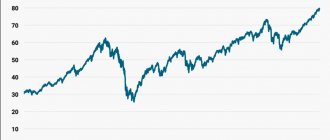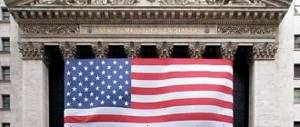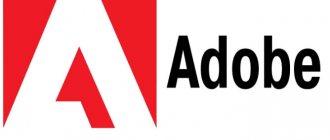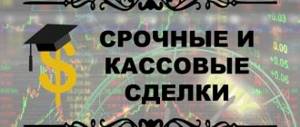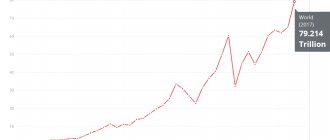Hello, dear reader!
The word “Wall Street” has become a household word not only for all investors in the world, but also for ordinary people. At the same time, an immediate association arises with huge money and crowds of American brokers shouting orders to buy and sell in the stock exchange pit.
Wall Street may be the largest securities exchange in the world in terms of turnover, but it is far from the only one in the United States and in North and South America.
The American stock exchange is our topic today.
Distinctive features of the American market
A distinctive feature of the American market is the variety of financial instruments: more than 5 thousand shares, about 1000 depositary receipts, more than 2000 ETFs, bonds. For comparison, the Russian market is represented by about 2,000 debt instruments, and in terms of shares - about 280 securities. American exchanges are multinational; securities of both national and international companies are traded here. Among the market participants, there are our domestic public companies, the bulk of which are also represented on the Moscow Exchange. For example, depositary receipts of the Russian MTS, Chinese Alibaba, Indian Tata Motors and 1000 other foreign companies are in circulation on the US market.
The American market provides investors with great opportunities in terms of sectoral diversification of investments. In comparison with the same Russian market, represented by 17 sectors, securities of issuers from 20 sectors of the economy are traded on the American market. If we compare the structure of the Russian and American markets, then: the Russian market, as a direct reflection of the resource-based economy of the Russian Federation, has a significant bias towards the oil and gas and mining sectors; in the US market, the technology and financial sectors stand out in terms of capitalization. Each sector of the US market is in turn subdivided into several industries. In total, companies from 129 industries are represented on the US stock market.
Finally, the main distinguishing feature is that in the American stock market, unlike Russia, there are many exchanges: from small ones to global giants, varying in scale and range of instruments provided. The variety of trading platforms is a definite plus for investors. Firstly, exchanges, competing with each other, can offer more favorable conditions for their clients. Secondly, greater liquidity of investments is ensured: an interesting fact is that securities of the same issuer can be traded on several platforms under the same ticker. At the same time, buy/sell orders submitted by the investor are broadcast by the broker to all platforms at once, which allows transactions to be completed with minimal losses and transaction costs.
American currency session opening hours
Trading times for major currency pairs and trading platforms. Chicago time. For time in Moscow in winter you need to add 10 hours, in summer - 9.
Features of trading during the American trading session
The beginning of the main trading session on American exchanges coincides with the last couple of trading hours (depending on the time of year, Americans change the time, in Russia they do not) on the Moscow Exchange plus the evening session on FORTS. Movements of the American market, especially at the release of important American statistics, are immediately taken into account in the movements of Russian quotes.
There was a time when one of the most liquid instruments of the MICEX - futures on the RTS index - walked as if tied to the American futures on the S&P500. Golden time for algorithmic traders. As the most liquid and largest American market, it sets impulses on the Russian market.
Time differences in the operation of the main sites
The main trading hours of the main American exchanges are shown in the figure. Source - ru.investing.com. On this page online you can determine the trading time relative to your local one.
American market structure
The list of participants in the US stock market, their tasks and functions are similar to the structure of the Russian market (see the article “How the stock market works”): the exchanges themselves, investors, issuers, clearing organizations, brokers. The regulators of the trading process, by analogy with the Central Bank of the Russian Federation in Russia, in America are two main financial institutions - the Federal Reserve System (FRS) and the Securities Commission SEC. There are also a number of independent agencies that create rules for the interaction of stock market participants and monitor their implementation (FOMC, FINRA, etc.).
As for the US exchanges themselves, there are currently more than 10 of them operating here. And if you look at the history of market development, many trading platforms were formed here, some of which over time could not withstand competition and went out of business, others consolidated into groups . Of the entire existing modern list of exchanges, some operate as independent stock players, and some are part of transnational exchange holdings. Some are universal, and some are specialized.
The figure shows, as an example, a list of exchanges where shares are traded from the foreign trading terminal Trader Workstation:
In addition to stock exchanges, there are derivatives exchanges. From the variety of US exchanges, in our article we will talk in detail about several of the largest trading platforms that have their own distinctive features and deserve special attention:
- Intercontinental Exchange Group (this includes the New York Stock Exchange NYSE, Chicago CME).
- American Stock Exchange (NYSE MKT LLC, formerly AMEX).
- NASDAQ OMX Group.
- CBOE Global Markets.
- BATS Exchange.
Option 3. Opening an account with an American broker
As the name suggests, this method involves working directly with a foreign broker. To enter the NYSE and NASDAQ, you independently choose a broker, open a brokerage account with him (aka an account) and fund it from your foreign currency account opened in a Russian bank. In this case, you work with a foreign broker not through an intermediary company, as is the case with a sub-brokerage scheme, but as an end client.
- Decide to open an account with Interactive Brokers (IB) - register using my affiliate link. After following the link, select the account type “Individual”, and then everything will be in Russian.
As a result, you get a personal account, a transparent work scheme, lower costs and a high level of security. However, there are costs here. In particular, you may need: more time to prepare and fill out documents (how much more depends on the broker) and more patience when interacting with bank employees (how much more depends on the bank).
| Pros of option 3 | Disadvantages of option 3 |
| Working with an American broker directly and on your own behalf. The right to receive dividends as a direct holder (owner) of securities. | A more labor-intensive process for replenishing a brokerage account. |
| Access to all assets and instruments traded on US exchanges. | Required to complete and update Form W8-BEN. * |
| Often lower fees and no trading platform costs. | Possible costs (exchange fees, subscription to market data, etc.). |
| The ability to transfer securities to another broker in kind, that is, without selling them. | Obligation to independently submit a declaration (3-NDFL). ** |
| $500 thousand insurance coverage for the account in case of bankruptcy or license revocation. | Some brokers lack Russian-language support. |
*Completing Form W8-BEN is required to avoid double taxation.
Obviously, despite all the possible difficulties, interacting with a broker directly is the most reliable option in terms of investor protection. However, in order for you to compare the conditions for opening a brokerage account for each option, I have compiled them into a separate table (see below).
Intercontinental Exchange (ICE)
Intercontinental Exchange (ICE) is the world's largest exchange holding company, which includes a network of 12 exchanges and 6 clearing centers. It is the world's largest operator of the derivatives market. Founded in 2000 in Atlanta, Georgia. The company's offices are located in various parts of the world: the USA, Great Britain, Singapore, etc., which allows it to work around the clock every day, including weekends. In addition to exchange organizations, ICE includes firms providing financial services (SuperDerivatives) and financial analytics (IDC). The acquisition of NYSE Euronext in 2013 allowed it to take a leading position in the list of international operators in the stock market.
Initially, the exchange was only involved in trading energy resources (oil, natural gas, electricity). Today, on ICE electronic platforms, investors are offered simply a huge selection of instruments - more than 12,000 items from 9 asset classes - commodity futures and options, currency futures, popular indices, stocks, debt market instruments, etc. In response to the growing needs of digital asset turnover, the company launched the Bakkt project - a global ecosystem for digital money (including Bitcoin). ICE's advanced integrated digital platforms provide clients with greater capabilities in implementing business and trading strategies - access to trading, messaging, analytics and other functions.
One of the remarkable facts of ICE is that it is on its trading floors that the reference price for Brent oil and a number of other commodities is determined.
Since 2005 Intercontinental Exchange went public. Currently, the company's capitalization is about $50 billion. More information about the company, including financial indicators and historical dynamics of securities quotes, can be found in our Radar service on the Intercontinental Exchange issuer page.
The company's securities are included in the calculations of such reputable stock indices as the Russell 1000 and S&P 500.
Exchange website: https://www.theice.com/index
Among the largest exchanges consolidated in the Intercontinental Exchange are the New York Stock Exchange (NYSE), the Chicago Stock Exchange (CME).
Masterforex-V warning about the fall in market capitalization during crises in the world
Masterforex-V Academy, despite growth in 2021 capitalization of the world's leading stock markets, warns that the global crisis is “just around the corner” and that it is too late to open Buy transactions at the current tops of stock indices and blue chip stocks. On the contrary, during this period you need to prepare for Sell transactions and a powerful fall in all stock markets of the world without exception.
Remember: a crisis is the best time for professional traders and investors to make money . Read more: Masterforex-V: how to make money on global financial and economic crises.
Best regards, wiki Masterforex-V.
New York Stock Exchange (NYSE)
The New York Stock Exchange (NYSE) is the largest American stock exchange. Founded in 1792 as a result of the Buttonwood Agreement between brokers. It is the earliest registered securities trading organization in New York. The main building is located on Wall Street, a street that is secretly considered the world center for stock trading. Since 2013 The NYSE is owned by the holding company Intercontinental Exchange (ICE).
More than two thirds of all stock transactions in the world are made on this platform. The market capitalization is more than $23 trillion (almost 25% of the global market).
Today, there are more than 4,200 tickers listed on the NYSE, mostly blue chips and high-growth companies. Among them are the most valuable companies in the world. The total capitalization of securities traded here significantly exceeds that of other world exchanges. The exchange has intercontinental status; many companies around the world are trying to gain access to trading. Traders on the NYSE can enjoy a wide range of benefits, including access to capital, enhanced branding and visibility, and increased liquidity. NYSE-listed securities benefit from increased market quality in the high tech/high touch model. In order for a company's securities to be listed on an exchange, it must meet certain requirements, so not all issuers can trade here.
NYSE offers investors:
- Wide range of tools.
- High-quality trading tools - the best time to update quotes, high-speed trading terminals allow you to execute transactions in record time in fractions of milliseconds.
- High liquidity of securities (on average, 5% of all registered securities are traded on the stock exchange per day; on days of rebalancing of indices and redemption of options, this value reaches 10%).
- Reliability of investments. In addition to supervision by national financial institutions and insurance, the exchange listing rules themselves provide an additional reserve of reliability.
- Transparency of information in the last minutes of the exchange's operation. Data is sent every 5 seconds to major information providers such as Bloomberg and Thomson Reuters.
Trading on the NYSE is conducted from Monday to Friday from 9:30 to 16:00 local time (Moscow time from 16-30 to 23-00).
The NYSE exchange is currently one of the innovators in the investment business (electronic digital format of work, integrated sales system, etc.). At the same time, thanks to a number of traditions, it retains its authenticity - since the founding of the exchange, the ringing of a bell has been the signal for the beginning and end of trading. Among those who were awarded the right to launch trading on the stock exchange were famous people in politics, sports, music, public figures and even cartoon characters. The New York Stock Exchange is always governed by a 27-member Board of Directors. The number of individual members of the exchange is 1366, mostly brokers. Membership can be purchased or rented. The cost of a “membership card” reaches 3 million dollars. Moreover, almost a third of the total number of places are rented.
The NYSE calculates such significant stock market indicators as the Dow Jones index, S&P 500 and the NYSE Composite index.
Exchange website: https://www.nyse.com/index
Chicago Stock Exchange (CME)
The Chicago Stock Exchange (CME GROUP INC or CME for short) is one of the world's largest commodity exchanges. Founded in 1874, located in Chicago. Joined ICE in 2021.
Initially, the objects of trading were such commodity assets as butter, eggs, onions, potatoes, pork, turkey, etc. Over time, the list of traded assets went far beyond the boundaries of the list of food counters. Currently, the most popular derivatives market instruments are futures and options:
- For goods (metals, energy, agricultural products).
- For currency (about 20 world currencies).
- On world stock indices (America, Europe, Asia).
In addition to the listed instruments, non-standard ones are also presented here, for example, weather futures, surges in real estate prices.
During the day, the trading volume on the exchange is about 15 million contracts, a third of which are futures, the rest are options.
Since 1982, CME has moved to automated trading on its proprietary global electronic platform, Globex. Trading is conducted 6 days a week around the clock. About 80% of trading is conducted in electronic format, and 20% by the so-called “card” method. You have probably seen something similar to card trading in some American films - this is trading not remotely, but in the hall with active gesticulation of the trading participants making transactions, in their weapons - such unusual exchange instruments as a card and a pencil. Participants have their own unified sign language for the purchase, sale, quantity, series of assets, on the date of execution of the event. After the transaction is completed, the data is entered into the system, and trading participants on the Globex platform see these transactions with a certain delay.
Since the mid-90s, the CME exchange has calculated the VIX volatility index, which assesses the degree of uncertainty in the stock market among investors. It reflects traders' expectations based on bid and offer quotes for index options contracts. For some investors, the index value serves as a signal to close trades.
Since 2002 CME GROUP INC. carried out an initial public offering of its shares on the NASDAQ stock exchange. The company's market capitalization is more than $70 million. Company page with financial indicators in our Radar service - CME GROUP INC.
Exchange website: https://www.nyse.com/markets/nyse-chicago
US Stock Market Daily Review
Comment of the day
The stock market posted modest gains in choppy trading Thursday afternoon as investors took note of new economic stimulus measures aimed at easing the impact of the coronavirus pandemic. The ECB began buying bonds worth EUR 750 billion, and the US Federal Reserve launched another emergency lending program to support money market mutual funds.
At the same time, the Big Three US automakers announced plant closures in the US, Canada and Mexico, and initial jobless claims jumped 70,000 to 281,000 (seasonally adjusted) for the week ending March 14.
The Dow rose 0.95%, the S&P added 0.47%, and the NASDAQ added 2.30%. The price of oil also rose to almost $25.50/bbl, and the price of gold to $1,480/oz. (+$2).
Market Review:
Operating in a new reality
In response to business closures due to the coronavirus, Argus analysts made changes to their forecasts for GDP and company profits from continuing operations. As the pandemic evolves and reactions from businesses and consumers evolve, we will adjust our forecasts accordingly.
We watch, wait and work (remotely)
On March 16, a new, most unusual week in history began for Americans. Millions of employees have begun working from home, with varying degrees of efficiency, and this situation may continue for quite some time. Other categories of workers (police officers, firefighters, health care workers) report working in conditions of almost deserted streets. Even among doctors, everything is quiet so far, since the pessimistic scenario with an influx of infected people has not yet come to fruition.
Never before have so many Americans been away from work without the timing of their return to work being unknown. Never before have workplaces been so adaptable to remote work. According to a 2018 study by Swiss commercial real estate company IWG, about 70% of office workers work remotely at least once a week. This percentage includes sales and travel employees. According to an analysis by Flexjobs and Global Workforce Analytics, the number of remote workers has increased by 91% over the past 10 years. The study found that in 2021, about 4.7 million office employees worked remotely, compared to 3.9 million in 2015.
The greatest concern during the period of social isolation and pandemic are those types of businesses that are already under attack. These are companies that provide services to consumers that are not essential (for example, cruise trip organizers, airlines or offline retail stores).
SMBs will either face only a few months or weeks of downtime or exit the market entirely. The government has already promised to take measures to support SMEs (providing loans and possible deferrals or benefits on tax payments), but small companies may face serious problems.
The energy market is also going through difficult times due to a sharp drop in oil prices. A return to normalcy means a recovery in demand for energy, including gasoline (for cars) and natural gas for household needs (such as air conditioning). However, not all sectors will return to normal functioning. After the shocking events of the last 2 months, how long will it take for cautious consumers to continue to be carefree in the crowd? But this is precisely what is necessary for the successful functioning of stadiums, cinemas and even churches. The answer to this, as to other questions that the current situation has posed to us, is unknown.
Strong economic fundamentals ahead of pandemic
Business activity does continue on some scale, and this does not only apply to those areas that produce necessary goods or services. In New York, popular retailers have reduced their hours but remain open. For example, both Stop N Shop and Trader Joe's are open until 7:00 pm or close a little earlier. At the time of writing, Walmart has not announced any changes to its hours.
We have already said that the pandemic has found the US economy in good shape, and perhaps this will be the best recipe for its rapid “recovery.” Data published recently indicate a high level of economic activity in the recent past. While these data certainly do not reflect the current turbulent situation, they do signal a gradual expansion of the economy in anticipation of a more favorable trading environment.
In February, the US consumer price index (CPI) maintained its annual trend and increased by 2.3% y/y. Core CPI growth (excluding food and energy prices) was 0.2% in February (+2.4% over the previous 12 months). This figure is sure to change in the coming months as lower energy prices mean lower gasoline prices and lower home heating bills.
In addition, the dynamics of producer prices in February showed that the global economy is already reacting to bad news from China. The producer price index (PPI) for final demand decreased by 0.6% in February. Unadjusted, the final demand index rose 1.3% in the 12 months ended February 2021, and the final demand CPI excluding food, energy and trade services prices rose 1.4% over the past 12 months.
At the end of February, consumers were still trying to remain optimistic in the face of the looming pandemic. However, according to preliminary data, the University of Michigan consumer sentiment index for March decreased to 95.9 from 101.0 in February. A more significant decrease in the index of future expectations (by 6.8 points to 85.3) is a signal that consumers felt a global problem was approaching (for comparison, the index of current conditions remained at a high level - 112.5).
Adjusting Forecasts
As March comes to an end amid growing uncertainty, Argus analysts now see a higher chance of a recession mid-year. Our preliminary revised forecast assumes negative GDP growth in 2Q20 and 3Q20. Note that a decline in GDP over two quarters, according to the textbook definition, constitutes a recession.
We also lowered our expectations for GDP growth in 1Q20 to 0.8% from 1.5% previously. In 2Q20 and 3Q20, we forecast a moderate decline in GDP by 0.3% (in each quarter). As the economy normalizes, we expect the indicator to grow by 0.8% in 4Q20. In 2021, we forecast US economic growth of 0.2% (previous forecast – growth of 1.9%). We note that GDP growth in 2021 may exceed the original forecast, which is typical for an economy that has experienced a recession.
Argus is also lowering its forecast for S&P 500 earnings from continuing operations in 2021 and 2021. We now expect 2021 earnings from continuing operations to decline by about 10% to around $146. Based on this, we have lowered the corresponding forecast for 2021 to $162 (original estimate: $180).
As part of our continuing operations model, which differentiates earnings by sector and quarter, we sharply cut forecasts in the energy, materials and financials sectors. Forecasts for companies in the industrial, technology and consumer discretionary (cyclical) sectors were lowered more moderately. In the latter sector, weak results in the travel and leisure segment could be partially offset by growing activity in the housing and auto finance segments amid lower rates.
It is worth emphasizing that we are talking about preliminary revisions to GDP and EPS forecasts - estimates may change in the future. We expect to update these forecasts frequently in response to current changes in the situation.
Summary
Although the forecasts may seem too pessimistic, reality is constantly changing. Under normal circumstances, the stock market would have already bottomed out. It seems that the stock quotes are based on a pessimistic scenario (prolonged closure of businesses, collapse of individual sectors and cases of company bankruptcy). The forecast may also include a rapid increase in the number of cases and deaths under the Chinese and Italian scenarios. However, things could still change.
Despite the apparent deterioration in consumer and business sentiment, the transition to social disunity and business closures due to the pandemic has been disciplined and self-organized rather than disorderly and state-sanctioned.
At some point, stocks will again become attractive to a critical mass of investors. Strong sell-offs will be followed by a favorable entry point. The US stock market went from a mild OW in mid-February to an increasingly pronounced UW as it fell. Argus will continue to monitor the situation in real time and provide updates to economic and investment strategies.
Market view
Argus revises sector recommendations
We have revised our recommendations for the allocation of weights to different sectors in portfolios. Below we provide our forecast for the calendar year 2Q20.
We have upgraded our TMT sector recommendation to OW from EW. Despite ongoing pressure on the sector (regulatory action against companies that own social networks and increased competition between telecommunications companies), these problems are taking a back seat to the spread of the COVID-19 virus. Within the sector, the “islands of relative stability” and sustainable profits are giants like Verizon and AT&T.
We downgraded the financial sector to EW from OW, and upgraded the consumer cyclical sector to EW from UW. We downgraded the energy sector again to UW, dropping the sector's weighting in the S&P 500 to just 3.5% (the same as for utilities). We do not see any prospects for a recovery in oil prices in the near future after their decline caused by both cyclical and one-time forces.
Rebalancing occurs 4 times a year: at the beginning of March, June, September and December. Argus recommends that investors use its findings to re-weight stocks in their own portfolios to benefit from valuation imbalances.
We recommend that you pay attention
AT&T INC. (NYSE: T) BUY
AT&T is a key stock in our Equity and MinVol model portfolios.
The already large AT&T has significantly expanded its business in recent years through a series of strategic acquisitions, including Time Warner in 2021, First Responder Network in 2017 and smaller deals. These steps allowed the company to transform from a stable wireless/wireline operator in the US market into a conglomerate with a diversified business. Given the current market conditions, AT&T management plans to focus on profitable subscribers rather than chasing less competitive segments. The purpose of the latest transactions, according to management comments, was to reduce the debt burden. In addition, the company plans large share repurchases over the next 3 years.
Update recommendations
Medtronic (NYSE: MDT) Confirmed BUY
“We continue to highly value Medtronic’s long-term growth prospects, but we pay attention to the impact of the COVID-19 pandemic (a reduction in the number of elective surgeries in hospitals and, accordingly, sales of medical equipment).
— The company has strong positions in relevant market categories. Medtronic is strengthening its competitive advantage through new product launches and M&A transactions.
In response to the need for ventilator systems for patients with coronavirus, the company has more than doubled its own production capacity and supplies of ventilator systems from Ireland. However, we believe that any factor affecting the company’s activities related to COVID-19 is temporary and expect a recovery in volumes.
— We are lowering our 2021 adjusted EPS forecast to $5.55 from $5.63 and our 2021 adjusted EPS forecast to $6.05 from $6.12.
— We have revised the company's target price to $115 from $135 due to increased market volatility. We continue to appreciate Medtronic's long-term growth prospects, based on its strengths in minimally invasive therapy, brain therapy, pain management, and its global diabetes business.
Accenture (NYSE: ACN) Outlook revised but remains positive; confirm BUY
— Accenture shares rose 7% on March 19 amid general market uncertainty after the company cut its full-year revenue forecast but maintained growth expectations for fiscal 2020.
— Accenture reported a record volume of pre-orders of $14.2 billion (+20% for the year). While this was largely the case before the pandemic, management remains confident in the business's prospects.
“Accenture is committed to helping clients navigate this challenging period of uncertainty by continuing to invest in people and operations.
— We confirm “BUY” until the security reaches our target price over a 12-month horizon of $235.
Anthem (NYSE: ANTM) Affirmed as a BUY given its status as a leading healthcare insurer
“We expect enormous pressure from the coronavirus pandemic on Anthem's 2021 financial results as the company has decided not to impose deductibles or mandatory coverage on insureds for virus testing and other services.”
— On a positive note, we note the likely support for Anthem from the launch of its own pharmaceutical intermediary IngenioRx in 2Q19. Management believes the move will allow the company to add $2.30 to EPS in 2021.
— The company is supported by its scale and strong balance sheet. According to our scale, we assess the company's financial stability as moderately high.
“We believe Anthem shares, which trade at 9.0x our 2021 EPS guidance, are undervalued. We have revised our target price to $235, which implies a 10.5x multiple of our 2021 forecast and upside, including dividends, of more than 19% from current levels.
Technical assessment
Unfortunately, we can now compare the 2021 market decline to the October 1987 crash. The S&P 500 fell 12% on Monday, its worst drop since October 19, 1987, when the index plunged 20.5%. It is worth noting that back in 1987, the index fell from around 340 to levels around 220, and now it has dropped from levels around 3,400 to levels around 2,200.
Then, after reaching an all-time high of 336.77 (August 25, 1987), the S&P 500 collapsed to 224.83 on Black Monday, October 19. Within 38 days, the index lost 32.8%. This time, the index also fell from its all-time high (February 19, 2020), losing 29.5% in just 18 days (the biggest drop since 1987).
It is worth recalling what happened next in 1987, since it seems that we can only compare the current situation with that period. After hitting its closing low on October 19, 1987, the index fell another 3.7% during the day on October 20, 1987. However, from that day's intraday low of 216.46, the index rebounded sharply and was up 19% by the close of trading on October 21, 1987.
Thereafter, the S&P 500 experienced high volatility in the 220-260 range until it broke out of it into a new 250-280 range in February 1988. The index did not accelerate into strong growth until the final months of 1988, i.e. throughout the year after the collapse. The index managed to regain its lost positions only by July 1989 - approximately a year and nine months after Black Monday.
What can we expect from the current situation? We cannot give an accurate forecast based on just one comparison. The only thing we can say based on the history of observations is that the recovery from the bottom after a large collapse may be delayed.
A technical look at paper
Home Depot
Home Depot is the world's largest home improvement and building supplies retailer. The company sells appliances, tools, paint, lumber, plumbing and electrical fixtures and other home and garden products in a warehouse store format. About 31% of total sales come from plumbing, electrical and kitchens, another 29% from hardware and seasonal items, 21% from building materials and 19% from paints and flooring.
Recently, like most other securities, HD shares have fallen sharply in price - from $240 (March 4) to a recent low near $140. During the decline, quotes broke through the 200-day average and are now testing the 200-week average area near $170. The stock price fell to potential support on the chart near $150 (December 2018 low). If it manages to stabilize and return to levels above the $165 area, it could continue to rise towards $200-220. Due to the strong decline, resistance from above is unlikely.
We recommend setting a stop loss slightly below the support level on the charts ($140) and taking profits in the $190 area.
Cisco Systems
Cisco is a world leader in the production of telecommunications equipment. The company was originally created to produce routers and switches for Ethernet-based intranets, and now Cisco has expanded its business to collaborative systems, data centers, video providers, security systems, wireless services, analytics and other segments in the field of networking equipment and software .
The CSCO share price fell sharply towards support in the $31-33 area. In mid-February, the company's shares cost $50, and over the past month they have fallen to $32.40. The securities formed a daily bullish momentum divergence after a cyclical transition into oversold territory. Over the past few days, unlike many other securities, CSCO quotes have managed to rebound on above-average trading volumes. CSCO encountered initial resistance at the 21-day exponential moving average ($39.40) on Thursday before falling back. If the securities manage to overcome this level, they are unlikely to encounter resistance before reaching the $43-44 area.
We recommend setting a stop loss just below the support level on the charts ($32.40) and taking profits in the area of $43-44.
Previous analytical reviews can be read at Argus Research, BCS Global Markets
American Stock Exchange (NYSE MKT LLC, formerly AMEX)
The American Stock Exchange (NYSE MKT LLC, formerly AMEX) is one of the US stock exchanges, founded in 1911 in New York. Currently renamed NYSE MKT LLC and owned by the NYSE. Capitalization – about 1 trillion. dollars.
The company's heyday came in the second half of the 20th century, when the number of companies listed on AMEX almost equaled that of NASDAQ. But after the launch of the electronic trading platform on the NASDAQ exchange, there was a significant outflow of trading participants. In response to the current crisis conditions, the company began to look for alternative ways of development - expanding the list of available tools, launching the listing of foreign companies. These measures brought a temporary effect. During these difficult times for the exchange, AMEX “passed into the hands” of NASDAQ, then there was a buyback. But in the end, in 2008, amid the global economic crisis, AMEX finally lost its viability - it lost its sovereignty, being taken over by the NYSE and renamed NYSE MKT LLC.
Today, NYSE MKT LLC is the platform for listing and trading of small and mid-cap companies. In the exchange environment, it is considered a “springboard” for the acceleration of small companies, which subsequently, upon reaching a certain level, go to the NYSE exchange.
The exchange owns its own AMEX MII index, which was later renamed the NYSE Arca Index. It includes a large 20 companies such as Coca-Cola, McDonalds, General Electric, IBM, Microsoft and others.
Exchange website: https://www.nyse.com/markets/nyse-american
Other North American exchanges
Below I will look at other American trading platforms.
Bats global markets
Founded in 2005 by programmer Dave Cumings. Headquarters are located in Lenexa, Kansas. Offices in New York, Chicago, London, Singapore. The Bats Global Markets exchange group includes 4 stock and 2 options exchanges in the US, a platform for European securities and currency trading. Buts Europe started operating in 2008.
In 2021, CBOE Holdings was acquired and operates as a division of this holding.
NASDAQ
NASDAQ is the world's second largest stock exchange by capitalization. The history of its foundation dates back to the 70s of the 20th century. NASDAQ was founded as a result of a policy aimed at automating the securities market. The full name of the exchange is the Automated Quotation Service of the National Association of Securities Dealers. It was at Nasdaq that for the first time in the world, trading began to be carried out in electronic format.
Initially, shares of high-tech companies (production of electronics, software, etc.) were traded on the NASDAQ trading platform. But subsequently the market became an object of global trade for companies from a wide range of industries.
Despite the fact that this is a fairly young exchange, it is among the TOP 3 major stock exchanges in America (together with the NYSE). The market capitalization of the exchange (all companies represented on its platform) is about 12 trillion. dollars (about 11% of world capitalization). The capitalization of the exchange itself is about 19 billion US dollars.
The exchange is owned by Nasdaq, Inc., which, in addition to the NASDAQ exchange, manages eight European stock exchanges, including the Armenian, Copenhagen, Helsinki, Icelandic, Riga, Stockholm, and Tallinn exchanges. Nasdaq, Inc. became public in 2002 with an initial public offering of its shares on the NASDAQ trading platform.
Currently, more than 3,000 companies are represented on the exchange. Among them are such well-known technology giants as Apple Inc., Intel Corporation, Microsoft Corporation, NVIDIA Corporation, Adobe Inc.
Exchange hours are similar to those of the NYSE from 9:30 a.m. to 4:00 p.m. NY time. Trading on this exchange is different from a regular stock exchange. To maintain liquidity, NASDAQ employs market makers who are required to execute client orders using their own reserves in the absence of a counter offer. The result is the formation of quotes for this asset.
The exchange calculates the following stock indices: NASDAQ Composite and NASDAQ-100.
Exchange website: https://www.nasdaq.com/
What kind of exchanges are these?
Initially, trading platforms in America arose for the purchase/sale of two main positions - securities (usually American stocks) and various goods - oil, grain, agricultural products, etc. Stock markets began to specialize in the first group, and commodities - in the second .
With the development of the economy and exchange trading, new groups of instruments appeared - derivatives or derivatives (options, futures), which began to be divided into various trading platforms, such as the CBOE exchange.
According to Bloomberg, as of March 2021, the global stock market capitalization, that is, the market value of public companies whose securities are traded on exchanges, amounted to $80 trillion. Of these, 36.3% are from one country—the United States.
All data is shown in the table. Source: Forbes
Chicago Board Options Exchange (CBOE)
The Chicago Board Options Exchange (CBOE) is the largest options exchange in the United States. The exchange was founded in 1973. Operated by CBOE Global Markets. The company's capitalization is $13.6 billion.
CBOE occupies one of the leading positions in a wide range of financial instruments: second place in terms of stock turnover (20% of the total volume) among market operators, the world's leading operator in options (30% of the US market), in foreign exchange transactions - 15% of the world volume, hosts approximately 12% of all US ETPs (280 products from more than 50 issuers).
CBOE operates four exchanges - BZX Exchange, BYX Exchange, EDGA Exchange and EDGX Exchange.
2,200 companies cooperate with the Exchange, and there are also 22 stock indices (including S&P, NASDAQ-100, Russell 2000, etc.) and 140 ETFs.
Exchange website: https://www.cboe.com/
Commodity and derivatives exchanges
Below is information on American commodities and derivatives trading platforms - derivative instruments on the underlying asset.
Chicago Mercantile Exchange CME
Chicago Mercantile Exchange (CME) is the largest derivatives marketplace. The world's largest number of options and futures are simultaneously listed on the exchange. Founded in 1898. The American CME belongs to NYMEX, COMEX, CBOT. 90% of trades go through CME Globex, an electronic trading platform owned by CME.
Chicago Board Options Exchange CBOE
Chicago Board Options Exchange. In short - CBOE. Established in 1973, the Chicago Board of Trade (CBOT) is one of the oldest American exchanges, founded in 1848.
SVOE today accounts for more than half of options trading on the US stock market. The largest holding. Trading instruments include US and European stock futures, global foreign exchange (FX), and volatility products.
SVOE is the world's largest ETP trading platform. ETP (exchange-traded product) products include exchange-traded funds (ETF), synthetic funds (ETV), exchange-traded notes (ETN), certificates.
Stages of development:
- 1975 Introduction of computerized price reporting;
- 1977 Put options trading begins; SVOE buys Midwest Stock Exchange's options business;
- 1983. Beginning of trading on the S&P500 and S&P100 stock indices;
- 1989. Interest rate options trading begins;
- 1992. Beginning of optional trading on economic sectors and international indices;
- 2001. Launch of the electronic trading platform CBOE Direct;
- 2003. A hybrid trading system is launched - traditional “in the pit” plus electronic trading;
- 2004: The CBOE Futures Exchange opens. Trading in VIX volatility index futures begins;
- 2005. Short-term weekly options are created for the first time;
- 2008. Annual trading volume exceeds 1 billion contracts;
- 2014: VIX futures trading becomes 24/7. Trading volume on global markets reaches 1.4 billion contracts;
- 2015. CBOE acquires Livevol, Inc., a large American developer of options technology software;
- 2017. Purchase of Bats Global Markets. This brings SVOE to a leading position as an exchange holding company on whose platforms derivatives are traded.
The management structure is Cboe Global Markets. An IPO was held in 2010, and trading in shares began on June 15. Cboe Global Markets owns and operates four options exchanges: CBOE Options Exchange, Cboe C2 Options Exchange, Cboe BZX Options Exchange and Cboe EDGX Options Exchange.
Intercontinental commodity exchange ICE
Intercontinental Exchange (ICE) is the world's largest exchange holding company. It manages twelve exchanges and markets in different countries with different specializations of trading. The list includes futures exchanges in North America and Western Europe, the NYSE, options exchanges and over-the-counter trading platforms.
ICE was founded by Jeffrey Spretcher in 2000. Initially, the American exchange was created as a centralized platform for trading energy contracts. The exchange community was offered transparency of transactions, high liquidity and lower transaction costs relative to over-the-counter trading, which dominated the industry until the creation of ICE.
With the growth of the American exchange, in addition to contracts for petroleum products, natural gas, energy, agricultural products, currency derivatives, and stock indices were added to the instruments traded.
In 2013, the deal to acquire NYSE Euronext was closed, the main structure of which is the NYSE - number 1 on the planet in terms of capitalization of securities of issuers from around the world listed on it.
Main products traded on ICE:
- Derivatives on agricultural products - sugar, milk, wheat, etc., financial instruments, crude oil and refined products, energy, natural gas and gas condensate, rare metals, gold, silver, copper.
- Over-the-counter trading (ICEOTC) for oil, natural gas, energy.
This information is reflected in the ICE presentation below. Main directions and tradable instruments (symbols are deciphered at the bottom of the page).
Philadelphia Stock Exchange PSE
Philadelphia Stock Exchange (PHLX) is the oldest exchange in the United States, founded in 1790, transactions were initially concluded in the Merchants Coffee House. In 1874 it had 198 seats.
Stages of development:
- 1949 - merger with the Baltimore Stock Exchange;
- 1954 - merger with the Washington Stock Exchange;
- 1969 - acquisition of the Pittsburgh exchange;
- 2007 —NASDAQ buys PHLX for $652 million, deal closed in 2008.
As of 2014, 3,600 stock options, 15 index options and currency options were traded here. US-based PHLX has a 16% US market share in equity and ETF options trading.
Boston Exchange
Boston Stock Exchange (BSE) began operating in 1834 in Boston, Massachusetts. Acquired by NASDAQ in 2007. Today it operates as the American subsidiary of NASDAQ and trading platform, symbol NASDAQ OMX bx.
Pacific Exchange
Los Angeles Stock Exchange is a Los Angeles oil exchange that merged with the San Francisco stock exchange in 1957. Until 2001, it acted as a trading platform for oil and petroleum products of the regional Pacific Exchange. Then it was closed.
New York Mercantile Exchange
In 1872, American farmers created an exchange for trading agricultural products - milk, butter, cheese.
The bulk of the global volume of derivatives for petroleum products and crude oil comes from Nymex.
In 1994, it merged with the American COMEX non-ferrous metals exchange. Since the merger, both exchanges have existed as two trading divisions within NYMEX Holdings Inc. The main difference is in the specialization of the contracts traded. NYMEX is energy resources, platinum, palladium, agricultural products. COMEX - gold, silver, copper, aluminum.
In 2006, NYMEX and the Chicago Mercantile Exchange (CME) agreed to make contracts available for 24-hour trading on the CME's electronic GLOBEX system.
In 2008, the Chicago Stock Exchange absorbed the NYMEX.
Since 1994, it has been structurally operating as a holding with 2 divisions - NYMEX Division and Comex Division.
In the asset structure, let's look at the positions of the NYMEX Division.
Today, assets are concentrated in the following areas:
- energy resources;
- agricultural products;
- metals.
Trading today on the NYMEX is conducted through authorized members who have official status as a Commercial Hedger, Proprietary Trader, Institutional User, Trader Investor, and Investment Advisor Wealth Manager. .
Opening hours are 24 hours a day (Monday-Friday), including electronic trading hours on Globex.
A total of 261 participants from 35 countries were registered and admitted to trading.
New York Metal Exchange
COMEX is a division of the New York Mercantile Exchange that trades derivatives on non-ferrous metals. COMEX is one of the world's main trading platforms for futures and options on gold and silver. The most liquid with the highest turnover are gold futures, ticker GC. In addition, options on copper, futures on aluminum, zinc and steel coils are traded.
BATS Global Markets
BATS Global Markets is the third largest US exchange holding company by capitalization with an emphasis on innovative services. Since 2017 is part of CBOE Global Markets. BATS is present in the USA, Singapore and the UK. Operates four US stock exchanges, two US stock options exchanges, a pan-European stock market and a global market for trading foreign exchange products.
The company was founded in 2005. in Kansas City, Missouri. This happened at a time when the two largest US stock operators (NYSE Euronext and NASDAQ OMX Group) carved out a niche of 90% of the US market and increased prices for their clients. Since its founding, the company has positioned itself as a private exchange offering companies more favorable listing conditions. And this technique worked. The company began to grow rapidly, and the exchange's trading turnover began to increase significantly.
BATS was founded by programmer and software developer D. Cummings. It is not surprising that the advantages of the new trading platform were not only more favorable price conditions compared to the current monopolists, but also a convenient, well-thought-out service using information technology.
The focus of trading on electronic services and the use of advanced electronic trading services provide an operational advantage for the company. The company's costs are more than 10 times lower compared to key competitors NASDAQ and NYSE. Another distinctive feature of BATS Global Markets from other classic stock exchanges is the absence of listing requirements.
The exchange market capitalization is 5.4% of the global figure. The share of trading on this exchange is 10-12% of the total daily trading volume in the United States. The exchange controls about a quarter of the shares of the European and American markets and about 10% of the US options market. The exchange calculates the BATS 1000 index.
Company website: https://markets.cboe.com/
US Stock Market - How to invest with Admiral Markets?
If you are interested in investing in the stock market and would like to invest in public companies from around the world, you can explore the Invest.MT5 trading account where you can enjoy benefits such as:
- Opportunity to invest in thousands of stocks and ETFs from 15 of the largest exchanges in the world.
- Opportunity to open an account with a minimum deposit of just €1 and invest from as little as $0.01 per share with minimum transaction fees of just $1.
- Access free market data in real time, without delays and at no additional cost.
- Creating a stream of passive income in the form of dividend payments.
- Ability to use the world-famous MetaTrader 5 trading platform with various asset classes.
You can start trading right now by clicking on the banner below and enjoy all the features described above and much more!
